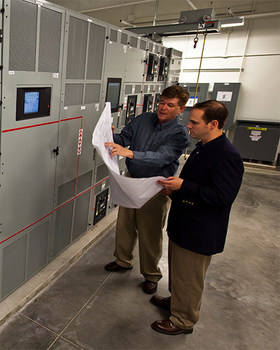
If your facility is like most, equipment and loads are continually added or removed in small increments, constantly changing your electrical infrastructure. The impact of these changes is not always apparent until some part of the system becomes overloaded or exhibits other problems. Keeping your single-line diagram up to date provides a road map that enables proper protection and system reliability, and is necessary for NFPA 70E compliance.
Whether you have a new or existing facility, Vertiv can help create or update your single-line diagram. A comprehensive site survey is conducted to inventory your equipment, verify drawings and processes, and evaluate design redundancy. The resulting detailed schematic clearly shows the main components of your electrical system and the power distribution path. With your up-to-date diagram, you will have a better understanding of the electrical distribution system layout and design in your facility. You’ll have the information you need for system analysis and testing, as well as future maintenance and engineering studies including short circuit, coordination, load flow/power factor, power system, arc flash, and reliability studies.
More information Manufacturer's Website
Technical Summary
Site Survey
Performing an on-site survey of your electrical system is the first step to creating or updating a single-line diagram. Trained Vertiv™ technicians collect information to determine the elements that need to be deleted or added in the overall schematic. Doing this creates a building block of knowledge. Once the survey is complete, our team will create a new, professional single-line diagram for your records. The site survey services are as follows:
- Inventory all equipment
- Confirm all loads connected to emergency/standby feeders
- Verify potential single-points of failure
- Evaluate overall system design and determine whether the system can be maintained without shutdown
- Verify that a process to maintain up-to-date drawings is in place
- Update customer-provided single-line diagrams and provide an AutoCAD formatted version
- Provide a report of findings with any recommended actions
Single-Line Diagram Development
The single-line diagram is the blueprint for electrical system analysis. It is the first step in preparing a critical response plan, allowing you to become thoroughly familiar with the electrical distribution system layout and design in your facility. A typical diagram will include:
- Incoming lines showing voltage and size
- Incoming main fuses, potheads, cutouts, switches, and main/tie breakers
- Power transformers (rating, winding connection and grounding means)
- Feeder breakers and fused switches
- Relays (function, use and type)
- Current and/or potential transformers with size, type and ratio
- Control transformers
- All main cable and wire runs with their associated isolating switches and potheads (size and length of run)
- All substations, including integral relays and main panels with total load of each feeder and each substation
- Critical equipment voltage and size (UPS, battery, generator, power distribution, transfer switch, computer room air conditioning)
Single-Line Diagram Review and Update
Following a site survey, Electrical Reliability Services engineers will update existing single-line diagrams or complete electrical system drawings as needed. This update will incorporate any changes to the infrastructure, note load changes, add missing components, and correct inaccurate information.
Compliance and Safety Check
Many electrical systems transform over time, causing concern for safety issues. That’s why NFPA 70E requires an accurate single-line diagram for each facility. Our staff of highly trained professionals put their end-to-end expertise and knowledge of electrical industry code regulations to use to ensure compliance and safeguard your business.
Brochures
Manuals
Technical Specs
Resources
Related Pages
- Arc Flash Studies and Training
- Circuit Breaker Testing
- Energy Recommendations - Return on Investment
- Electrical Assessment
- Electrical Safety Training
- Ground Fault Testing
- Infrared Services
- Load Testing
- NERC Compliance Services
- Partial Discharge Testing
- Permanently Mounted Sensors
- Power Quality Studies and Harmonic Analyses
- Power System Reliability Studies
- Protective Relay Maintenance and Testing
- Relay Design and Integration
- Safety Audits
- Short Circuit and Coordination Studies
- Thermal Control Optimization
- Transformer PM